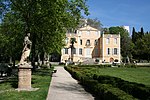Unité d'habitation

The Unité d'habitation (French pronunciation: [ynite dabitasjɔ̃], Housing Unit) is a modernist residential housing typology developed by Le Corbusier, with the collaboration of painter-architect Nadir Afonso. It formed the basis of several housing developments throughout Europe designed by Le Corbusier and sharing the same name. The most famous of these buildings is located in the southern part of Marseille, France. It was added to the UNESCO World Heritage List in 2016 because of its importance to the development of modernist architecture, along with 16 other works by Le Corbusier. It is also designated a historic monument by the French Ministry of Culture. It was damaged by fire on 9 February 2012.
Excerpt from the Wikipedia article Unité d'habitation (License: CC BY-SA 3.0, Authors, Images).Unité d'habitation
Boulevard Michelet, Marseille 8th Arrondissement
Geographical coordinates (GPS) Address Website Nearby Places Show on map
Geographical coordinates (GPS)
| Latitude | Longitude |
|---|---|
| N 43.261323 ° | E 5.396261 ° |
Address
Unité d'Habitation - "Cité Radieuse" (Cité Radieuse)
Boulevard Michelet 280
13008 Marseille, 8th Arrondissement
Provence-Alpes-Côte d'Azur, France
Open on Google Maps



